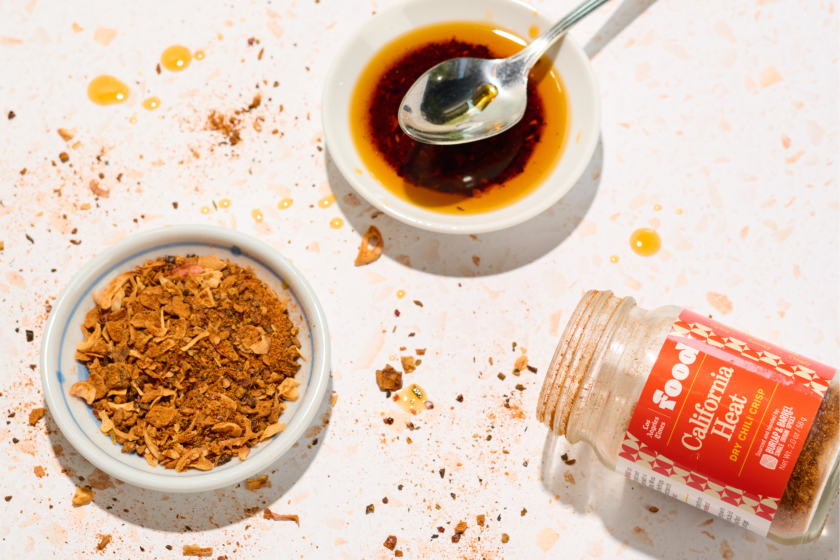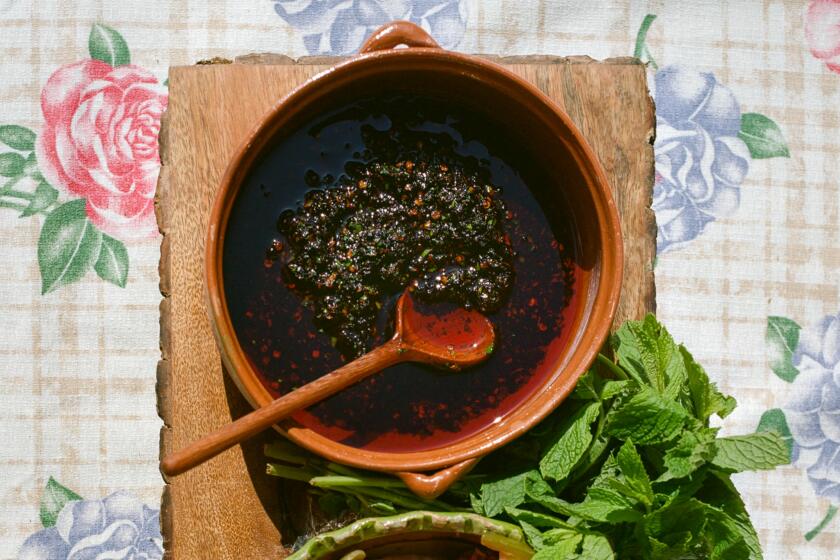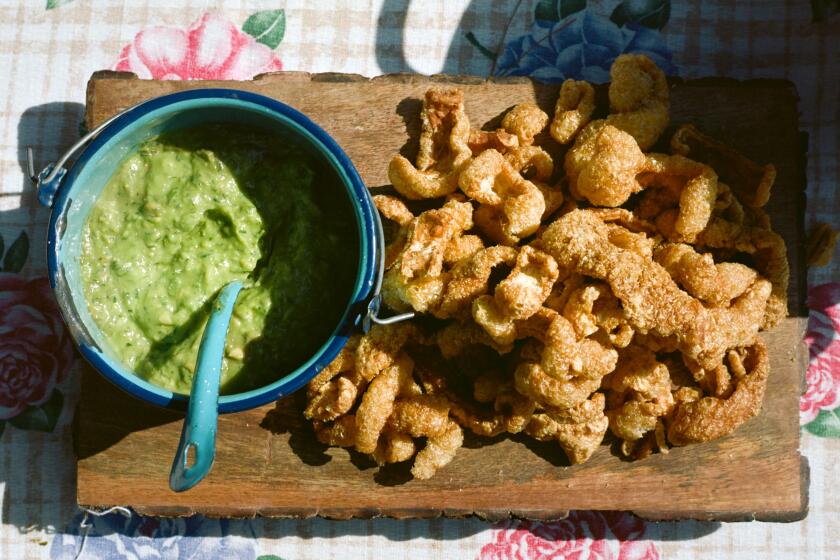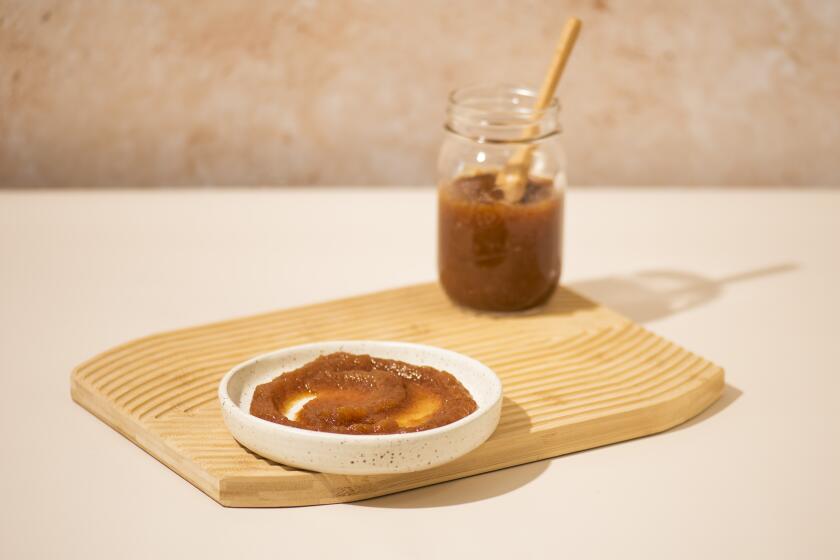Salsa verde

For me, the most sublime pork roast imaginable is one that is cooked for a very long time at a very low temperature until the meat is so tender that it falls apart if you look at it and exhale. First seared and rubbed with herbs, this meat will smell divine as soon as it hits the heat, and it will continue filling the house with heavenly aromas all through the cooking day, which can last from sunup to darkness. The meat is ready when it is “fork tender,” or, I would go so far as to say, “meat pudding.”
In central Italy, summer evenings are greeted with the intoxicating aroma of porchetta cooking in fennel and garlic, rock salt and peppercorns. At most open-air food markets around the country, the lines are always longest at the porchetta stand, where these most delicious of sandwiches come un-relished and dripping with juice. Any cook who has eaten porchetta in Italy would probably only dream of replicating this dish -- a whole pig boned and slow roasted in a wood-burning oven -- at home.
Lately, L.A.’s chefs have been turning out some splendid porchetta.
Over at Rocca restaurant in Santa Monica, Tuesday night is known as “the celebration of the pig.” But the celebration begins on Saturday, when chef-owner Don Dickman receives a shipment from Niman Ranch: a 100-pound pig in a white box. Dickman oversees the Saturday preparation of porchetta, which involves lancing the meat and vigorously massaging it with a “pesto” made from fresh rosemary, whole fennel seeds, garlic, olive oil and kosher salt. (As Dickman puts it, “It’s not just rubbed; we get it in there big time”). It will marinate until Tuesday, when it will be cooked for five to six hours at 300 degrees.
Then, on Tuesday night, a diner at Rocca gets a plate of well-seasoned porchetta and sides of salsa verde (a piquant anchovy-parsley sauce), fruit mostarda (applesauce with dry mustard and mustard seed) and a vegetable (lately it has been broccoli rabe ). This is a fragrant and satisfying dinner -- rustic in the sense that it is a plate full of meat, fat and bones, the kind you pick your way through and in which every bite might differ from the last. The crispy skin is the crowning achievement, and you tend to portion it so you can have some with every forkful.
*
Do try this at home
At Angelini Osteria on Beverly Boulevard in Los Angeles, Gino Angelini serves his version on Saturday night; it’s not really porchetta but a pork leg. Seasoned beautifully with fennel seed, garlic and a bay leaf, a leg is cooked for about four hours at 350 degrees, then sliced at the table. At Lucques, Suzanne Goin serves her porchetta -- in this case, suckling pig -- about eight weeks out of the year, depending on when she gets hold of the meat. She marinates it in rock salt, thyme, rosemary and sage for three hours, then does a confit -- that is, she submerges it at 225 degrees in duck or pig fat overnight, about seven hours. At La Buca on Melrose, Loredana Cecchinato serves her porchetta -- also leg -- about once a month, dry-roasting it unadorned in salt and pepper.
As unlikely as it might sound, it is a simple matter for the home cook to achieve a remarkable porchetta facsimile -- the dripping juice, the melting meat -- and without coming face-to-face with Babe. You just need the right cut, and you want to cook it for longer and at a lower heat than the chefs are doing. The dish you’re actually cooking is spalla di maiale arrostita tentamente (slow-roasted shoulder of pork). Not a lot of work is required; a little prep, a little attention and a lot of slow roasting will net you a dish that is so tender it will make a grown man cry.
Slow-cooking a pork shoulder means choosing one of two cuts of meat. The proper shoulder is called the Boston butt or pork butt (and, incidentally, the actual “butt” is called pork leg). This is the best, most flavorful cut. If you want to serve skin, however, you’ll need the picnic roast, or picnic shoulder. The underside of the shoulder, this cut has more sinew and tendons than the butt roast. Slow roasting melts away much of the fat and sinew. You’ll either have to order a skin-on picnic roast from your butcher, or look for it in groceries in neighborhoods with strong Latino and Chinese populations.
Bruce Aidells, sausage impresario and author of “Bruce Aidells’s Complete Book of Pork,” says both the butt and the picnic cuts have their strong points, and both are better for roasting than the leaner loin cuts. “Pork producers sell many more loin chops than they do shoulders,” he says. Both he and pork producers find that to be a shame. For his slow-roast pork, Aidells uses the picnic roast, even though “there’s a fair amount of grizzle” running through it. “It’s dirt cheap,” he says. “You can’t get nice slices from it, but that doesn’t matter because we’re talking about a falling-apart kind of roast.” Still, he admits the butt roast is just the nicer cut. “There’s a lot more meat on the butt and a lot less waste.”
For our part, we roasted both picnic and butt roasts, and we are now all about the butt roast. It consistently gave us an incredibly tender, juicy, falling-apart meat with a wonderful flavor. While we loved the crispy skin you can get with a picnic roast, we found that cut to be unpredictable; correct cooking times varied widely as did flavor -- some of the roasts achieved wonderfulness but others never got as tender and full of flavor as the porchetta of our dreams.
I had heard tell of a great, long-roasted recipe from “The Cafe Cook Book: Italian Recipes from London’s River Cafe” by Rose Gray and Ruth Rogers. This method, the legend went, truly approached porchetta as done in Italy. With its garlic, fennel seed and red chile, the flavor combination is fairly classic; it can also be found (plus rosemary) in Aidells’ pork book.
Using the Gray and Rogers recipe as a jumping-off point, we cooked what seemed like 900 porchettas (OK, maybe 10 or 12), in order to determine the best cooking time and method.
First you score or lance the meat and rub in the herbs. Next, brown the roast in a heavy enamel cast-iron pot (Le Creuset works very well). Pour on lemon juice and chicken broth. Gray and Rogers say it can go for as long as 24 hours; we beg to differ. After 16 hours the meat dries out and takes on an ominous stormy look and starts to lose flavor.
Here’s what we say: Let the roasting commence. Begin with the pot uncovered at 450 degrees; after half an hour, cover it, and turn the heat down to 250. Eight hours, 10 hours -- you and your fork will be the judge. This produces the moistest, most pudding-like results. As for the bone-in/bone-out question: both are equally good. But bone-out is easier to find. If you opt for bone-in, add an hour of cooking time.
This, we feel, is the perfect porchetta. Even if it really isn’t porchetta.
Wash parsley, basil and mint leaves and spin dry in a salad spinner.
In the bowl of a food processor, combine the parsley, basil, mint, anchovies, capers, mustard, garlic and red pepper flakes.
With the motor running, slowly add the olive oil. It should form a relatively smooth puree that is slightly chunky. Season with salt and pepper to taste. Makes 1 cup.
Get our Cooking newsletter.
Your roundup of inspiring recipes and kitchen tricks.
You may occasionally receive promotional content from the Los Angeles Times.















